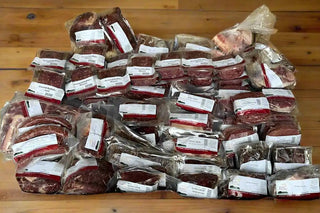Gardeners all over New England are putting on their best overalls (the ones with the least holes, of course) and heading out to the garden to get ready for spring. We are planting seeds, pulling weeds, tilling beds, and hauling compost...lots of compost. Thankfully here at YFM, we have plenty of the "black gold" to go around - and our buffalo are making more everyday! One of the most common questions we get asked about our compost is, "How much do I need?"

While the simplest answer to that question is usually "more," because compost solves many garden woes, you can get a bit more precise with more information. Different gardens and plants require different applications at different times. However, our list below provides a decent rule of thumb for a few common scenarios to help you figure out your compost needs.
New raised bed - 1/3 to 1/2 the amount of fill in the bed. So, if you have 8" high raised beds, you will need 4" depth of compost.
New in-ground bed - 3"-5" compost, lightly tilled into the top layer of soil.
Replenish raised or in-ground beds - 1-3" compost, gently worked into top layer of soil.
Potted plants - 1-2 handfuls for large pots, water in afterwards for best effects. For smaller pots, feed with compost tea instead - soak compost in water at a ratio of 1:2 for about a week. Drain the "compost tea" out, and use that to water your plants (you can feed veggies with this too!).
Vegetables - For long season veggies like tomatoes, peppers, squash, and cucumbers, add 1 handful compost to the hole dug at planting time. Add an additional handful at the base of the plant around mid-July to give the plants a boost for the rest of the season.
Fruit trees - 1" spread around tree out to the drip line, or 5-10#, whichever comes first. The drip line of the tree is where the rain drips off the ends of the branches. Make sure not to pile compost next to the truck, because it causes pest and disease issues.
So, now you know how deep to pile your compost...but how does that translate into yards, bags, quarts, etc? Check out this handy compost calculator to help do the math for you. Just enter the measurements of the bed, and how deep you want the compost to be, and it will shoot you out a number in both cubic yards and cubic feet. Just to be extra helpful, below is a conversion chart for the products we sell:
1 tractor scoop compost (available for pickup or delivery): 1.25 cubic yards
1 35# bag compost: .75 cubic feet
Hopefully these compost clues help you start your garden off right this season! Happy spring, gardeners!



